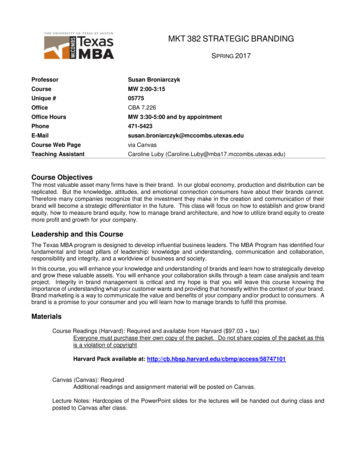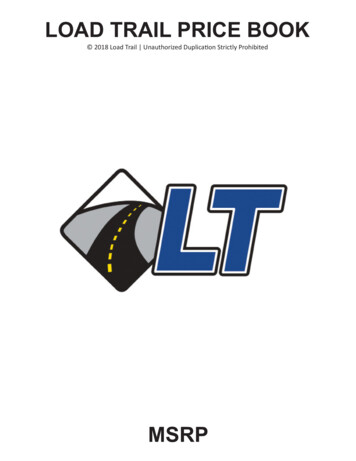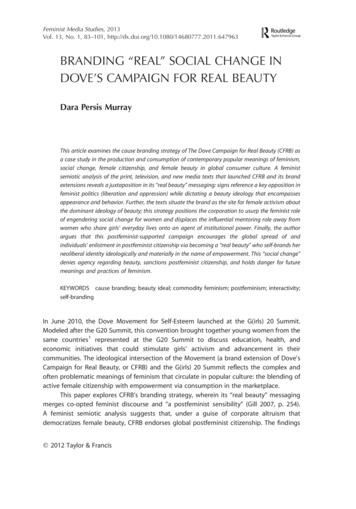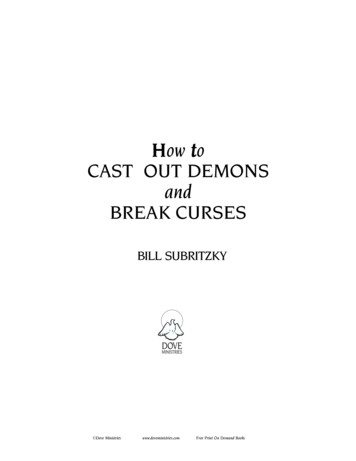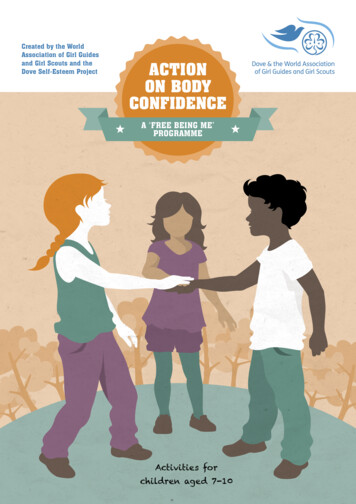
Transcription
Created by the WorldAssociation of Girl Guidesand Girl Scouts and theDove Self-Esteem ProjectActionon BodyConfidenceA ‘Free Being Me’programmeActivities forchildren aged 7-10
7-10s Action on Body ConfidenceA ‘Free Being Me’ programme, created by the World Associationof Girl Guides and Girl Scouts and the Dove Self-Esteem ProjectWelcomeThis programme will take you and your group on anexciting four-Challenge journey, supporting you toplan and run your own project to make a positivedifference to the lives of children and young people.in response to your feedback, asking for support totake action that doesn’t only raise awareness, butalso asks for change from decision-makers - this isadvocacy.Recent global Dove Self-Esteem Project research hasshown that when girls don’t feel good about the waythey look, 8 in 10 opt out of important life activitiessuch as engaging with friends or loved ones, and 7 in10 have not been assertive in their opinion or stuck toa decision. When girls don’t have confidence in theirappearance, they are being held back from reachingtheir full potential.Through games, discussions and creative activities,your group will uncover the reasons why some peopledon’t feel beautiful and unique and the problems thiscan cause, and plan an Action Project to make changehappen.WAGGGS and the Dove Self Esteem Project have beenin global partnership since 2013, bringing the FreeBeing Me body confidence activities to over 3.5 milliongirls and boys by the end of 2016. There is much moreto do! We have created Action on Body ConfidenceAfter you’ve taken Action, you will share what youdid online with Girl Guides and Girl Scouts worldwide,to inspire others and become part of the global bodyconfidence movement.Your group will earn the Action on Body Confidencebadge, available from the WAGGGS online shopwww.wagggs-shop.org or from your nationalassociation.Action onBody ConfidencebadgeAction on Body Confidence Activities for 7–10 year oldspage2
Actionon BodyConfidenceA ‘Free Being Me’programmeFour ChallengesYou should complete each challenge to gain your Action on Body Confidence badge. As a guide, wehave suggested the number of sessions you will need per challenge, however you are encouraged todo the programme at your own pace.Challenge 1Challenge 2See The ChangePlan The Change(over two sessions) Understand the issue Develop a vision of a bodyconfident world Agree a goal for your action andthe barrier to your goal you wantto help take away Agree ‘power people’ you wantto ask for change Make an action planChallenge 3Challenge 4Make The ChangeShare The Change Put your plan into Action! Celebrate your achievements Build your team Share your actions online Use tips and ideas for successfulAction Projects Plan what’s nextAction on Body Confidence Activities for 7–10 year oldspage3
BeforeYou Begin .Age groupSkill developmentThis activity programme is designed for ages 7-10. There isalso a version for older children and young people available.Some groups may wish to mix activities from this curriculumand the older curriculum.Participants will developskills in teamwork,planning, research,event managementand decision making,as well as campaigning,community actionadvocacy.How to useYou will need one meeting of around 1.5-2 hours forchallenge 1, two meetings for challenge 2, and at least partof a meeting for challenge 4. Challenge 3 will depend on theAction Project you decide upon.The programme is flexible. You can do all the activities overa few meetings, or spread over a term or longer. Or youcould plan your Action Project during a camp or holiday!Please ensure you follow the activities in order.Where it may be helpful, we have provided sometext in italics for leaders to read during some activities toensure the correct point is made. Feel free to adapt this, aslong as the key points are said.SupportFor training materials, ideas and inspiration fidenceFree Being MeAction on Body Confidence is a companion to the currentFree Being Me programme, which was produced by WAGGGSand the Dove Self Esteem Project in 2013. You do notneed to have done Free Being Me to enjoy Action on BodyConfidence.Free Being Me has reached millions of girls and boys andtheir communities worldwide already. Action on BodyConfidence has been created to support more girls andboys in Girl Guiding and Girl Scouting to plan and run ActionProjects that reach more people, in a meaningful way, aswell as provide the opportunity to share your ideas andexperiences with other members across the world.Action on Body Confidence Activities for 7–10 year oldsCommunityNeed support? Keen to share ideas? Join our Facebookgroup, and follow #FreeBeingMe or #LibreDeSerYo on twitter.Using social media and online engagementSome of the action ideas in this pack link to using socialmedia. We suggest that children under 13 are supervised byan adult if using social media. Please ensure that if sharingphotos or video, you have parent/carer permission. The SurfSmart programme has lots more guidance foronline safety. ety in the groupBody confidence may be an issue that affects members ofyour group. Create a safe learning space, by setting groupguidelines of respect, listening and not sharing outsidethe group. Create a safe space for girls/boys to retreat toif they are feeling worried or need a break. If you feel yourmembers need support on body confidence themselvesbefore they plan to Take Action, use the Free Being Meactivities then come back to Action on Body Confidence.Do you need more guidance on discussingbody confidence with your group?Read the Free Being Me Leader Guide downloadable fromfree-being-me.com or use the online GLOW FreeBeing Me courses.http://glow.wagggs.org/page4
Termsand DefinitionsThere are a few terms used within this programme and the11-25s version that WAGGGS has clear definitions for, whichwill help you understand the language used throughout.Body ConfidenceBody confidence is how a person feels about the way theylook. When we have body confidence we accept, and arehappy with, how we look and what our bodies can do.AdvocacyThe WAGGGS definition is We influence people to take decisions that will improve ourlives and the lives of others.This means: we influence (persuade) people - by speaking, doing andeducatingSelf-esteem to take decisions - for example on policies/rules, actions,attitudes, funding, support etc.A feeling of self-respect. Someone with high self-esteembelieves in themselves, and in their worth as a person. that will improve our life and the lives of others – aimingtowards the result we are trying to achieveAction ProjectCampaignThis programme aims to guide and give your group theskills and ideas you need to plan and deliver activities tomake a difference to the problem of low body confidence.Your Action Project activity can be advocacy, communityaction, campaigning or a mixture! To achieve the badge,your Action Project must reach at least 3 other people perparticipant, in a meaningful way – this is explained in moredetail in the programme.This is a planned series of actions that aim towards a set ofclear objectives, and aimed at a specific target audience.Image MythThis is the ‘ideal look’ that is defined by the society we livein. The Image Myth itself can vary around the world – forinstance the ideal in some societies for girls is thin, tannedand busty, whereas in others it is petite with fair skin.Globally girls, women, boys and men feel strong pressurefrom media, friends, family and others to achieve theirsociety’s version of this look. We call it the Image Mythbecause it is actually impossible to achieve every aspectof the look – and in reality there are lots of ways to bebeautiful or handsome.CommunityThis can mean a group of people living in the same area, ora group of people that have something in common, like acommon cause or interest. Community Action is any activitythat is run by a community or aims to make changes withina community.InfluencerThis is a person or group of people who have influence onthe decisions other people or groups of people make. Forexample, a group of pupils could have an influence over thedecisions a school principal makes. Or a blogger could haveinfluence on the behaviour of the people who follow herblog.Decision-maker For 7-10s: we don’t introduce this concept in the activities,but we do encourage the understanding that there isnot one ‘perfect’ way to look, through the princesses andprinces activity, and that the messages we see or hearthat say this are wrong.This is a person or group of people who has the power tomake decisions that affect other people. This could besomeone with national or global power like a President orPrime Minister, all the way to someone with power in a localcommunity like the editor of a local newspaper, or even aparent in a family setting.Action terms For 7-10s: we have simplified these terms for this agegroup by calling decision-makers ‘Power People’ – iepeople who have decision-making power over somethingand have the power to make change happen.These aren’t all introduced in these terms to 7-10s, but it ishelpful for you as the leader to understand what’s behindthe Action ideas.Action on Body Confidence Activities for 7–10 year oldspage5
Programme SummaryChallenge 1TimeActivitySee the Change - Session 1DescriptionSteps towards Action15 minsI am Unique!A game to celebrate each person’s uniquequalities and abilitiesLearn to celebrate themselves as they are,and recognise the importance of people’sdifferences – on the outside and the inside.15 minsThe Princess ListDraw a princess (or prince/action hero)character and identify the common featuresto help recognise the narrow view of beautythat is often promoted in society.Participants understand that there is anarrow definition of beauty presented in theirsociety.20 minsA Day in the LifeTake part in a fun interactive storyLearn about where appearance pressurescome from and how often they are experienced. Start to question the messages wehear that tell us to change the way we look.30 minsA Different Story!Create your own mini-plays to think aboutalternative ways Emi’s story could have goneThink about small changes that could happenwhich mean people do not worry about theway they look, and the difference this couldmake.5 minsA Free Being MeWorldA quick circle game to think about whatdifference it would make to the world ifpeople felt confident in the way they looked.Think about the end goals you could help toachieve and feel inspired to take action tobring about this change.Challenge 2TimeActivityPLAN THE CHANGE - Session 2DescriptionSteps towards Action30 minsWhat’s theProblem?Practice and perform small plays aboutproblems low body confidence can cause,and vote for your Action Project’s GoalUnderstand why low body confidence is aproblem and agree one problem you will helpto solve with your Action Project.30 minsBarriers in theway!A running and discussion game, and vote forthe issue you want to focus onUnderstand the barriers that stop peoplereaching your goal, and choose one to focuson in your Action Project.10 minsWho has thePower?An active guessing gameUnderstand what a power person is and whyit’s important to ask them for change20 minsOur Power PeopleCircle discussionAgree the power people you will focus on inyour Action ProjectAction on Body Confidence Activities for 7–10 year oldspage6
Programme Summary(continued)Challenge 2TimeActivity45 mins1 hourOur Plan of ActionPLAN THE CHANGE - Session 3DescriptionHold group discussions to plan the actionyou will takeChallenge 3TimeFlexibletime –dependson ActionchosenActivityRun your project40 mins-1meetingCreate your Action PlanMAKE THE CHANGE - Session 4DescriptionFollow your plan and work together to takeyour Action towards the Change you wantto see.Steps towards ActionMaking the action happen, and optionalskills-building ideasUse the tips and ideas, including: Monitoring your project How to influence people Building your teamChallenge 4TimeSteps towards ActionActivitySHARE THE CHANGE - Session 5DescriptionShare with theworldShare your group’s story on the Free Being Me websiteEvaluate!Ideas for how to evaluate your Action Project’s successesAction!Action on Body Confidence Activities for 7–10 year oldspage7
SEE TheSession 1 Activity 1ChangeI amunique!mins1) Ask everyone to draw rough lines on their paper toAt a glanceuee to celebrate each person’s uniqA gamqualities and abilitiesYo u will need15CHALLENGE 1son1 sheet of paper and a pen per perdivide it into 6 parts.2) Ask everyone to do their best to write or drawone answer for each sentence you read out, eachin a different part of their page. Make sure thenumbers are written down next to each answer.Explain that they will be sharing this with others inthe group.A step towards actionParticipants learn to celebrate themselves as they are,and recognise the importance of people’s differences– on the outside and the inside1What to do2Explain thatover the next few sessions, we aregoing to do some very special activities. As Girl Guides/Girl Scouts, we promise to make a difference to theworld we live in. The activities we’ll do will make adifference by helping people in our community feelmore confident and happy.Something that stops lots of people feeling confidentin themselves is that they worry about the way theylook – this can mean that they don’t feel as able todo lots of things, like going to visit friends and puttingtheir hand up in class. Just imagine the difference tothe world if everyone felt free to be themselves withoutthese worries!So, we’re going to learn more about why this problemhappens and why it makes people’s lives difficult,then think about what changes need to happen in ourcommunity to make a difference. We’ll think aboutwho could help change happen, and then plan anAction Project, to make our own change and spreadthe word about what our society needs to do to helppeople to be more confident and happy.This session, we’ll start by thinking about ourselves andwhy we are each special and unique just as we are!Action on Body Confidence Activities for 7–10 year olds3456What am I good at?(eg. Drawing)What do I like to eat?(eg. Bananas)What do I enjoy doing outdoors?(eg. Running)What do I look like?(eg. Long brown curly hairand green eyes)Who do I like to play with?(eg Tessa)What is my favourite game?(eg tag)3) Cut or rip up the papers to separate out the6 facts.4) Get into small groups of around 6. Ask groupsto lay out their papers and have a look at eachother’s so they remember what their group has.page8
SEE TheChangeCHALLENGE 1(continued)15I am unique!mins5) One group begins the game. Starting with7) Once the game is over, congratulate the teamsentence 1), they call out one person’s responsefrom their group. Eg: What are we good at?Drawing!The challenge is for the other small groups tolook at all their answers for 1), find somethingdifferent from the first group’s, and run to be thefirst to hand it to the leader who should stand ata distance away. The first group that reaches theleader wins a point!You could add a challenge byerincluding an obstacle course or oth.physical activities along the way Did anyone have the same answer as someoneelse? Were there lots of differences between everyone? What do you think the world would be like ifeveryone was exactly the same? (Boring? Not asmany new ideas?)6) Do the same for all the sentences. If you haveYou are all unique and special! Let’s all shout itout togetherI amunique!drawgwritinDiscuss: Do you think it’s good to have differences? Forinstance people all look different from each other,and have different skills and things they areinterested in.Tiptime, you could run the game twice over!with the most points. Ask everyone to put out alltheir papers onto the floor and spread them outto look at them all.ingtake photosathmingodsing ingpage9
SEE TheChangeSession 1 Activity 2CHALLENGE 115The Princess ListminsAt a glancew a popularIn small groups, participants draracter andprincess (or prince/action hero) chahelp themidentify the common features touty that isrecognise the narrow view of beaoften promoted in their society.Yo u will needCo-educational tipIf you also work with boys, follow theactivity instructions but create a separateadditional list about the ‘perfect-looking’prince, or action hero.et of paper forDrawing materials, one large sheprintout 1.each small group plus one extra,1) Organize participants into small groups of mixedStep towards actionParticipants understand that there is a narrowdefinition of beauty presented in their society.What to doImportant note: This activity is taken from the Free Being Meactivity pack. It is designed to help participantsidentify the limited, narrow definition of beautypromoted in their society. If your girls have doneFree Being Me, you may wish to skip this, but it isrecommended that you discuss the questions atthe end of the activity to remind everyone aboutthe issue. In this activity, the image of a fairy tale princessis used to help participants identify the limited,narrow definition of beauty promoted in theirsociety. Because younger participants may haveexperienced less media exposure, the activityfocuses generally on the idea that girls are toldthey need to look a certain way to be beautiful,and that this idea isn’t true. It intentionallydoesn’t explore the concept in depth or spend toolong breaking down the features of the ‘perfectlooking’ girl.Action on Body Confidence Activities for 7–10 year oldsages. Give each group a large piece of paper anddrawing materials.2) Ask each group to choose a popular fairy-taleprincess character they all know, and spend fiveminutes drawing a picture to show what theircharacter looks like. Encourage group membersto discuss the character’s specific appearancefeatures (e.g. long hair, blue eyes) as they draw.Focus on what the character looks like, rather thanwhat she is wearing.3) Bring the groups into one circle and put all thedrawings in the middle.4) On another sheet of paper, write at the top the‘perfect-looking’ princess?’Look at all these great drawings! Do you think theprincesses share similar features in the way theylook? Let’s see how many ways they look alike thatwe can spot.If the group gets stuck, help them with questionseg: “are they tall or short?” “What does her bodylook like?”When the group has finished creating the list, readthe features back to them.page10
SEE TheChange(continued)CHALLENGE 115The Princess ListminsSo the ‘perfect-looking’ princess has (Read out all the features on the list).Perfect-lookingprincess?Talk through the following questions, encouragingparticipants to shout out their answers:long hairblue eyes5) Ask afterwards. Isn’t it strange how similar all these princesseslook? (Yes!) Can you think of other places we see this princesslook? (Media, TV, toys, celebrities etc) In real life, do lots of girls have all these features?”(No)Sometimes it feels like the world around us istelling us there’s only one way to look beautiful,and we should all try to match that look. The wayprincesses are shown to us in films and on thetelevision is one way we get sent the message thatgirls and women should look a certain way. So do you think there’s really only one way to bebeautiful? (No)You’re right. Actually, we often get told the story thatthere’s only one way to be beautiful. The list youwrote describes the look that’s shown a lot in oursociety. But it’s not true – there are lots of ways tobe beautiful. There’s no such thing as a perfect look!Cross out the words ‘the perfect-looking princess’ thatyou wrote at the top of your list.We know there can’t be just one way to lookbeautiful, because even in this group we all lookdifferent and that’s even truer if you travel aroundthe world.At the end of this activity, take the princess picturesaway. They represent the unrealistic look expected bysociety so should not be displayed out of the contextof this activity.Action on Body Confidence Activities for 7–10 year oldsTip If your groups are struggling withtheir drawings, share out the pictures onprintout 1 to help them. While groups are creating their drawings,help them with questions, so they come upwith the features they want to show in theirdrawing e.g., “How tall is she?” or “How bigare her eyes?” “What shape is her body?”Encourage them to label these features ifthey want to. When creating the shared list, encouragethe group to focus on physical features anduse questions to help them be specific aboutwhat they are spotting e.g., “Their eyes looksimilar” “In what way? Are their eyes big orsmall?”page11
SEE TheChangeSession 1 Activity 3CHALLENGE 120A Day in the LifeAt a glanceyTake part in a fun interactive storYo u will needThe story printout 2minsEncourage them to think about where the ideamight have come from, eg their friends, TV,magazines, online and so on.2) Now take part in a fun story, a day in the life ofEmi the Owl!This story will show the group that these negativeappearance messages are around us all the time,and help them to understand and feel that this isnot how things should be.Step towards actionLearn about where appearance pressures come fromand how often they are experienced. Start to questionthe messages we hear that tell us to change the waywe look.What to do1) Explain that:We have just talked about how pictures and storieswe see and hear might make us feel like there isonly one way to look to be beautiful. But we knowthat’s not true!! We all know how important it isto feel proud of who we are and to accept otherpeople, too, and that each one of us is beautifulin our own way. Has anyone ever heard someonesay they wish they looked different to how theynaturally look?(Probably lots of children will put their hands uphere. Acknowledge that this is a lot, but don’tstart a conversation about what they wanted tochange – keep the activity moving)We’ve talked about princesses/princes/actionheroes which often look very similar to each other.We talked about how this could make us think thatthere is only one way to be beautiful. What else doyou think people see and hear as they go throughtheir day that might make people think they shouldchange the way they look to be beautiful?Action on Body Confidence Activities for 7–10 year oldsEmiTipAny other animal can be used in thisstory if you prefer – perhaps you could use anational animal of your country. You’ll just needto slightly adapt the story and use a differentanimal noise.Take part in the storyAny time Emi hears or sees any messages suggestingowls should change the way they look, you shouldstand up, wave your wings and hoot like an angry owl.Practice your hoots before you start!page12
SEE TheChange(continued)CHALLENGE 120A Day in the LifeminsDuring her day, where did Emi hear or see thosemessages about appearance and beauty?Answer:from radio, from unreal pictures,advertising slogans, friends, socialmediaCan you think about where else Emi could haveheard these messages?Ideas:TipIf you’d like to add more drama andmovement to this story, you could makepuppets, or even act out different parts ofthe story in groups.TV, films, family, magazines, infashion shops, on social media/onlineDo you agree with Emi, that the world wouldbe better if everyone felt free to be themselves,without worrying about how they look?Encourage all to say2) Discuss:(it is very important that you discuss thesequestions after the story)YES!How many times did you hoot?Answer:4 timesEmi heard all these things just in one day. Lots ofus hear and see messages like this every day. Howdo you think this might make some people feel?Answer:worried, sad, want to change theway they look, less confident, notrealise they are fantastic just asthey are, not want to go out andhave funAction on Body Confidence Activities for 7–10 year oldspage13
SEE TheChangeSession 1 Activity 4CHALLENGE 130A different story!minsAt a glancew thingsUsing creative and acting skills, shotly in Emi’sthat could have happened difference thatstory, and think about the differenstory.would make to the people in theYo u will needyou mayNo materials necessary, thoughps for yourdecide to dress up and create promini-plays.A differentstory!Ask each group toperform their mini playto the rest of the group,and briefly explainwhat’s different aboutwhat they acted out andwhat Emi saw or heard.Step towards actionConsider a world where people do not worry about theway they look, and the difference that could make.What to doDuring the Day in the Life story, you made your animal noises four times – there were four different thingsthat Emi saw or heard during her day that could havemade her think that looking a certain way is the onlyway to be beautiful.1) Divide the group into at least four small groups,and give each a group one of the situations Emiexperienced. If you have a big group, you can havemore than one group looking at the same situation.2) Challenge the group to think about a differentway each situation could have been, then makeup a mini-play to act out the new situation. Thereare some ideas below to help! You will need anadult or older girl with each group to help withthe ideas, but encourage the groups as much aspossible to think of them for themselves.Action on Body Confidence Activities for 7–10 year olds1Radio presenterscommenting on theway the president looked.This is a problem because: the president is onlybeing judged for what she looks like not for thedecisions she makes about how to run the country.How could this situation be different?Idea for the mini-play: The radio show could have a phone-in, and havesomeone call up to tell the presenters that theywere wrong to discuss only the way the presidentlooked – they could have a debate on the radio!page14
SEE TheChange(continued)CHALLENGE 130A different story!2The advertisementsignThis is a problem because it makes people feel moreworried about how they look when they’re on holidayrather than how much fun they have with friends andfamily.How could this situation be different?Idea for the mini-play: The advertisement could be for a product thatmakes your holiday more fun, that’s really positivefor example an advertisement for a camera whereeveryone looks real and like they are enjoyingthemselves in the pictures, or an advertisement fora swimming costume brand, which shows peopleswimming and using it on holiday, not just posing!3Suddenly everyonethinks Oli is cooland want to be friends with himbecause of the new way he looks.This is a problem because in reality, it’s much moreimportant to be friends with people for who they arenot what they look like – people should never be leftout because they look different.How could this situation be different?Idea for the mini-play: Oli’s school friends could treat him kindly andrespectfully all the time, so he doesn’t feel like heneeds to change his look to fit in. The play couldshow a quick ‘day in the life’ of Oli, including thingslike: he is complemented for something great he’sdone, is asked to join in games and join a lunchtable.Action on Body Confidence Activities for 7–10 year oldsmins4The party picture onthe phonesThis is a problem because the two friends arethinking more about how they looked rather thanhaving fun with their friends. They might worry moreabout going to a party next time and feel the pressureto look different.How could this situation be different?Idea for the mini-play: Show the two friends having fun taking the picturesat the party, then the next day at school showingthem to their friends, pointing out the amazing timethey had, what they danced to, what they ate, whowas there as so on. You could also have one friend who is worriedabout the picture of themselves, and the otherfriend reminding her how happy she looks, and theamazing fun they had, and how beautiful she looked.3) Quick discussionafterwards Do you think that the people in these situationsfeel more confident about themselves? How do you think that makes the people feel?(happier, want to do activities like holidays andparties and be a leader, worry less, be a betterfriend to other people.) Is it true that we need to look like our princesses/action heroes/princes to be beautiful? (NO!) Do you think enough people in the world knowthat it’s not true? (NO!) Do you think we should tellthem? (YES!)page15
SEE TheChangeSession 1 Activity 5CHALLENGE 1A Free Being Me WorldAt a glancewherePlay this game to imagine a worldlveseveryone feels free to be themseYo u will needugh for 1copies of printout 3 cut out – enostatement per person05minsPlay the game often known as ‘fruit salad’. Ask aparticipant to start by reading out her statement.If anyone else has the same one, they should runaround the circle and try not to be the last personto reach their place! Then the next person reads herstatement, and so on.If the leader wants everyone to run at once, she callsout ‘In my world everyone will feel Free Being Me!”and everyone calls out “Free Being Me!” and runsaround the circle and back to their place.Step towards actionParticipants think about the end goals they want theworld to achieve and feel inspired to take action tobring about this change.What to doDo you want to do something to make a difference,and help people feel free to be themselves and notworry about the way they look? Answer: YES!!printout 3, and cut themPrint or write copies ofout – you should have enough statements for oneper person in the group. Make sure more than oneparticipant has the same statement. Use fewerstatements if you have a smaller group.Stand in a circle. Mix up the statements andgive them out.Action on Body Confidence Activities for 7–10 year oldsCo-educational tipIn the statements, please change‘girls’ to ‘boys’, ‘children’ or just ‘people
WAGGGS and the Dove Self Esteem Project have been in global partnership since 2013, bringing the Free Being Me body confidence activities to over 3.5 million girls and boys by the end of 2016. There is much more to do! We have created Action on Body Confidence in response to your feedback, asking for support to


